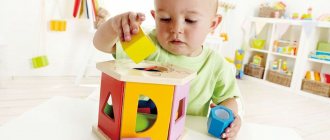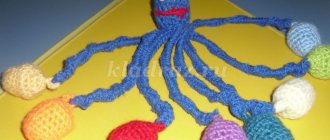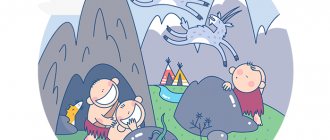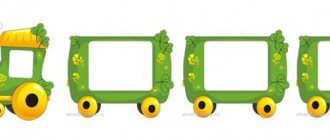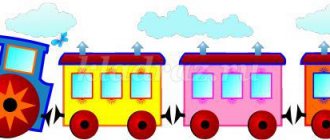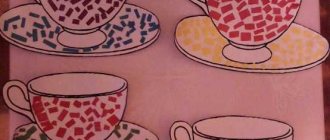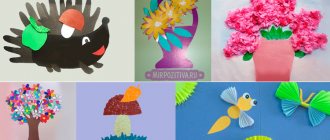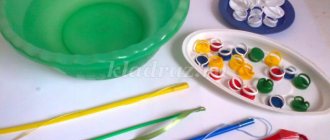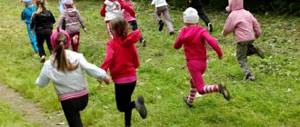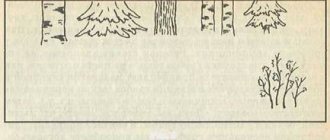Geometric applique
This article is intended for practicing appliqué with children.
Geometric applique will unobtrusively introduce the baby to the basic properties of objects: size, color, shape. The drawing is made up of simple geometric shapes. The application is associated with cognitive activity and has a huge impact on the development of the child’s creative and mental abilities. It will be of great benefit and will help develop work skills. When starting to introduce a child to an application, you need to remember three main rules: 1) the child cannot hold his attention for a long time 2) he should be interested 3) the child needs praise for the work done. Before starting class, cut out geometric shapes of different colors and sizes. Pay the baby's attention to the figure, its color and size. Help me put the shapes in the right order.
Flower applique.
If the child is still very small, then it is better to perform the application together. Place the flower on paper and ask your child to repeat after you. Show how to use glue and glue a picture. At first, use 2-3 geometric shapes in the application; for better memorization, pronounce the names and comment on your actions.
The flower is made of circles and squares. The circles are the petals of the flower, and the squares laid out in the shape of a diamond are the stem of the flower.
The caterpillar is made entirely of circles and only a small triangle is required for the mouth.
The butterfly applique will be more complex, it includes new geometric shapes. The number and size of parts increases.
It’s worth trying to make a general picture of geometric shapes with your child. First, work on each element of the future picture separately (flower, butterfly, caterpillar), and then assemble the overall picture. While doing appliqué with your child, ask him who he is portraying? Who are caterpillars and what do they turn into? By conducting classes using this method, the child’s horizons develop.
If it’s winter outside, then you should try to make a simple winter geometric applique.
First, we try to lay out the house from the figures, and then glue it onto the base for the applique.
We assemble the Christmas tree from green triangles, and from small circles we make beads for the Christmas tree. Everything is also simple with the snowman, it consists of circles of different sizes, one trapezoid and two different small triangles.
Application of geometric shapes “Cats and mice”.
Geometric paper applique. Garland.
Our task is to teach the child to stick exactly geometric shapes: circles and ovals, rhombuses and triangles, squares and rectangles, alternating them by color and shape. Show your child how to make a paper applique, imitating a garland on a string using circles and flags.
Ship made of geometric shapes.
The geometric application should be interesting, not very complex and not very simple, only then can the child be interested in the work. Cut out various geometric shapes from colored paper and construct different ships from them. It can be one large ship or several small ones, with sails or a funnel. Glue the result you like onto paper.
Source: https://detskiepodelki.com/podelki-iz-bumagi/12-geometricheskaya-applikaciya.html
Drawing with crayons - learning geometric shapes
With the onset of warm days, children spend a lot of time outside. There are a huge number of games here. Drawing with crayons on the asphalt is one of the favorite pastimes of children.
The classics never get old, just drawing different designs. However, you can combine business with pleasure. If you and your child study geometric shapes at home, then you can continue to get acquainted with them outside. What kind of games are these?
1. Studying the circle. Draw a circle. You can make a lot of interesting things out of it - a watch, a ball, emotional faces. Draw your child's attention to the fact that the circle has no corners (so the ball rolls easily). “String” circle beads onto the drawn thread. Start drawing beads for grandma and invite your child to continue. Can be combined with studying colors. Draw multi-colored beads, play the game continue the row - the adult draws a red, blue, white bead, and the child continues to draw a colored chain in the same order. Draw buttons with different numbers of holes, compare them, find the same ones. Next, you can draw a blouse and invite your child to “sew on” the buttons. Also draw a fruit tree, and the child will finish drawing the apples. Count your apples, talk about which ones are higher, which are lower, to the right, to the left, etc.
2. Studying the oval. Draw an oval, tell the child that this is a hollow, and he is a squirrel. Let him jump from one hollow to another. You can jump into a hollow, out of a hollow. At the same time, say that the baby is inside or outside. You can decorate the ovals. Invite your child to jump into a red hollow, into a blue one, and then not into a red or yellow one (the child must figure out which one). Make ovals of different sizes. Now you can complicate the task: “Jump not into the blue one or into the small hollow. Jump into the hollow to the left of the yellow one,” etc.
3. Studying the triangle. Tell your baby that the triangle is a handkerchief. But he's ugly. Offer to decorate it. And draw whatever you want on it. If you draw various geometric shapes, then tell your child that they are inside a triangle. Draw a Christmas tree from several triangles. You can make a lot of them and of different sizes - it will be a forest (the concepts of large, medium, small). Also, let the triangle turn into a mountain. We study the concepts of top and foot of a mountain. Invite your baby to use his fingers to reach the very top - why not finger gymnastics?
4. Studying the square. Now the squares are cages for animals in the zoo. Place animals there. You can draw them, or you can plant imaginary ones (sticks, twigs, leaves, pebbles). Also play the game "Robot". Draw a series of squares. Invite your child to be a robot - he will follow your commands: “Forward one square, back two squares, left one.” Then switch places.
5. Studying the rectangle. Draw a multi-story building. Be sure to pronounce the name of the figure. Say that the house is rectangular and the roof is triangular. You can draw windows of different shapes in this house. Place residents in the apartments (sticks, leaves, whatever). Count how many floors there are in your house. Let the child find someone who lives under a rectangle, above a square, between two ovals, to the left of a trapezoid, to the right of a circle, etc. You can draw several houses - this will be a city, draw roads, a traffic light. See what shape different objects are. Let toy cars drive along your roads and pedestrian dolls walk. Another option for playing with a rectangle is to imagine that it is a flying carpet. Tell your child that he is magical. And in order for it to fly, it needs to be decorated. You can also invite other geometric shapes to ride on a magic carpet. Let the baby “plant” them.
6. Studying the trapezoid. Tell your child that a trapezoid is a bridge over a river. Draw trapezoids of different sizes and different rivers (wide, medium, narrow). Invite your child to choose his own bridge for each river. And when the task is successfully completed, drive the car along the bridges. You can also dress a doll, and the clothes should be made of geometric shapes. For example, a jacket is a rectangle, a skirt is a trapezoid. Third option: a trapezoid is a snow slide. Ride a sled (leaf) down the mountain with your baby's fingers as passengers.
7. Studying lines. Draw a straight line and let your child continue drawing it. Draw a rectangle (this will be a fence), let the baby draw vertical lines - draw the fence boards. The tops are small triangles. Wavy line - waves on the sea. A great way to talk about sea life and vegetation.
These games can be played not only on the street, but also at home with pencils, markers, and paints. Enjoy your games and interesting study of geometric shapes!
Application templates from geometric shapes for children
Don't know what to do with your child? Great fun is creating appliqués from geometric shapes. This activity does not require special materials or preparation; it develops fine motor skills, imagination and thinking of the child, and is even very exciting for an adult. Appliqué is also often practiced in kindergarten, along with drawing, putting together puzzles, singing, etc. What types of applications are there?
Types of applications
People are accustomed to the fact that appliqué is a childhood hobby, but the beautiful mosaics and stained glass windows on the windows and walls of the most beautiful buildings in the world are also, to some extent, appliqué.
What is its essence? This is a set of individual parts assembled into a single whole (these can be either arbitrary geometric shapes or parts that have a predetermined shape and place in the finished drawing).
Applications can be made from different materials:
- From paper.
- From cardboard.
- From fabric.
- From cereals and seeds.
- From plant leaves.
- From threads.
- From rhinestones.
- From any other materials that can be attached to any base, thereby creating a pattern.
But still, paper remains the most inexpensive, simple and safe for a child, and therefore the most common material for creating appliqués. And the range of possible ideas for working with it is limitless. For example, using the appliqué technique from geometric shapes for children, you can make:
- Flowers and other plants.
- Animals.
- Cars, ships, planes, etc.
- Houses and architectural buildings.
- Little people and different clothes for them.
- Clowns, artists, magicians.
- Fairy tale characters.
- Collage in the form of a colorful rug.
- Entire story compositions.
Application "Owl" made of leaves and colored paper
For the little ones
At the age of 4–5 years, a child, of course, cannot independently come up with a composition, select details for it, cut them out and arrange them correctly on paper. Therefore, special coloring books with applications for kids were invented.
They already give the details. They just need to be cut out. All the details are very simple and are already painted. The contours of the finished drawing, and sometimes the background to it, are also given.
The parts just need to be laid out in the correct way, like puzzles, and carefully glued. Even a small child can easily cope with this task. True, you shouldn’t leave him alone with scissors .
Therefore, either cut out the parts yourself, or watch how he does it.
For example, you can make a funny hare or squirrel from circles and semicircles. And the cunning fox is made of triangles. These crafts from geometric shapes for children are very simple, the number of parts is only 5 or 6 pieces.
Applications for first graders
At the age of 6-8 years, the child’s skills are already more developed. Therefore, crafts made from geometric shapes for the 1st grade of school or the senior group of kindergarten have smaller and more complex details. In addition, a first-grader can already independently compose a separate object or even a small composition from them.
For example, a New Year tree made up of green triangles of different sizes (decreasing towards the top) and multi-colored bright circles representing balls. Such balls can be made voluminous by using rhinestones, beads, buttons or other similar details instead of paper.
You can develop the New Year theme and make Father Frost and the Snow Maiden, a snowman or some other characters associated with this holiday. Or create some other fairy tale plot.
Learning geometric shapes with kids in preschool educational institutions
When studying geometric concepts, children also gain other knowledge and skills in parallel:
- they learn to think logically;
- get the opportunity to develop knowledge of the Russian language;
- the perception of space and the ability to navigate in it improves;
- children develop fine motor skills;
- Intellectual qualities develop: the ability to make comparisons, analyze, and generalize.
Note! When teaching in kindergarten, the development of geometric concepts is not highlighted as a separate topic, but occurs in combination with other topics.
Children learn geometry
Learning colors and shapes for children from 2 years old
Geometry learning should begin with the simplest figures; more complex ones should be left for subsequent years. It is believed that children are able to perceive shape on a subconscious level within six months after birth. At this time, the main way of teaching is through mention during the story. When showing pictures, you can casually notice that the objects depicted have a certain shape.
When teaching, you need to take into account that kids can only learn to distinguish between the simplest ones: circle, square and triangle.
Note! Studying in a year or two or three should be easy and fun. For mastering it is convenient to use three-dimensional figures. Studying, for example, a circle, you can imagine that he came to visit the baby. You can use your child's finger to trace a circle along the outline. You can make such an applique, decorating it with eyes and a nose.
Drawing lesson on the topic “Who do you want to be” in preparatory groups
A child can play with this item: make a tower by placing one on top of the other, throw it to the side or put it in a box.
This integrated approach to a geometric design project is very effective for toddlers, but for younger children it can be considered the primary way to learn shapes.
For children under two years of age, the following may be used:
- children's ability to compare objects;
- use a children's educational set, where you need to select a hole of a suitable shape and size for the figurine.
A two-year-old child is able to choose the appropriate shape from a set.
When they teach figures to 3-year-old children, they can already show the one that was named by the teacher.
Learning figures for children 3 years old
When teaching children geometric shapes, it is important to consolidate familiarity with the material that they have previously learned. We need to continue studying and move on to those that are more difficult to understand - oval, rhombus and rectangle.
When teaching children, you can show children examples of figures, letters of the alphabet and compare them with other objects in shape and size.
Important! During the walk, children are told about the objects they see, mentioning their shape and simple geometric properties.
An important role when teaching geometric shapes to children is played by creative activities, when children draw or sculpt samples and put them together from a given set of component parts.
Using cards depicting complex objects, the child is asked to talk about the components in the form of certain shapes.
Children education poster
Geometric shapes in the senior group
At this time, the lessons move on to considering new, more difficult to understand figures, repeating those that they should have known before.
In classes at the age of five, children are asked to consider and talk about their common and different properties. For example, questions are asked about where open figures have corners and in which cases they do not.
They try to teach children to analyze the complex shapes of real objects, to find elements in them that have the form of simple figures. They learn about more complex shapes, such as a cone.
Geometric shapes in the preparatory group
At this age, children have already mastered the basics of understanding the shapes of objects. At this stage, it is important to develop knowledge and make it more systematic. At this age, children develop a foundation for schooling.
Note! Children in the preparatory group, when introduced to polygons, are told about their sides and angles, and are taught to find the desired figure using a description.
Here is an example of an educational game that can be included in a lesson note and used for teaching. Children are given a set of figures. The player places one of them. Another should put next to it one that differs in only one attribute. For example, if one offers a large blue square, then the other may lay out a small blue square, a large yellow square, or a large blue circle.
The teacher tells the children about the figures
Application of geometric shapes for children: patterns, animals and other DIY crafts
Creating an applique from geometric shapes is very similar to working with a construction set, only here it is paper and flat. Instead of cutting out ready-made silhouettes of animals, plants and other objects from colored paper and pasting them in the required order, the child assembles them from simple geometric shapes according to the “what looks like” principle. This is much more interesting than it might seem!
The benefits of geometric applique for the development of preschool children
From early preschool age to 1st grade, exercises on connecting simple shapes into a single image are very useful for children. They help the little ones learn and remember what geometric shapes there are, and consolidate the names of colors.
Classes with this type of application also develop:
- fine motor skills;
- accuracy;
- eye gauge;
- perseverance and attentiveness;
- skills in working with scissors and glue;
- imagination, the ability to think outside the box (the triangle looks like the face of a fox or a piece of cheese);
- the ability to design, taking into account the order in which the figures will be placed on the finished craft - the parts that should be further away are glued first, and those that are closer to the viewer can be layered on top of the previous ones (for example, if the bear stands half-turned, first it is attached to the background one of his paws, then his body, and only then his second paw).
In addition, the process of selecting the necessary details and composing them embeds in the minds of little creators the understanding that much in the world around them consists of geometric shapes, and the complex is made up of the simple.
Organization of the process
Geometric applique does not require serious artistic skills from adults to organize the process of children's creativity. The main thing is to provide the kids with all the necessary materials and tools, to organize a safe and convenient space for work.
In order for children aged 2–4 years to successfully make an applique, they need to prepare a drawing with clear contours and cut out the appropriate number of parts. At the same time, they may need a personal example from a senior, showing on the same blank what, where and how to stick.
At this age, children can already arrange geometric shapes on a sheet of paper without ready-made contours, looking at a sample. You can have them cut out parts with straight lines, such as triangles, themselves from lined sheets of colored paper. In this case, you should make sure that the scissors are safe - with rounded ends.
- For older preschoolers.
At 6–7 years old, children are able to trace simple patterns and cut out appliqué details themselves. At this age, it is useful to provide them with an independent choice of the color scheme of the craft: for example, when depicting flowers, geometric patterns, butterflies. This helps them learn how to combine colors and develops their creativity.
To ensure that the work lasts, use high-quality, not too thin colored paper and make sure that the glue stick has not dried out.
Examples of geometric applications
To conduct a lesson, just search on the Internet and print ready-made templates. For older children, you can introduce a loose theme by giving a few basic shapes that they can use in their appliqué pictures.
Cat
Application designed for the middle group of kindergarten. To work on the cat you will need geometric shapes:
- a circle with a diameter of 3.5–4 cm for the head;
- one large right-angled triangle for the body and two small ones for the ears;
- a square with a side of 1.5 cm is a foot;
- an elongated oval for the tail (the wider the figure, the fluffier the tail will be).
The large triangle should be placed on the sheet so that the smaller leg is at the base, and the head with ears should be placed at the upper sharp corner. Place a paw on the side of the right angle of the body, and a tail on the lower end of the hypotenuse.
Car
The truck consists of almost the same number of parts as the previous craft. A small complication is that the window will need to be glued to the top of the cabin - this will immediately change its appearance and bring the whole composition to life in the eyes of the child.
Required figures:
- 2 rectangles for the cabin and body;
- 2 squares - hood and window;
- 2 round wheels;
- 1 large semicircle is the sand that the truck carries in the back.
After gluing up all the parts of the truck, kids will likely want to draw a picture of the person driving the car in the window.
House
A plot-based application that gives scope for creativity and additional elements. In order to make a house with a courtyard, you will need to prepare:
- 3 rectangles are the lower part of the house, the door and the pipe;
- 3 squares - for windows;
- 1 circle and 8 small triangles for the sun and its rays;
- a narrow long rectangle and a large oval - a tree in the yard;
- 1 small circle for the center of the flower, 9 ovals for the petals and a thin rectangular strip for the stem;
- oval for a puddle in the yard.
Educational games with colored paper and geometric shapes
Wonderful square
If the child is 5 years old
Place a lined table in front of the baby (initially the figures are colorless, then colored). Now ask your child to find a figure on the table that is between two squares. Please note that there are two possible options (squares above - below, right - left). Let the baby find the figure located:
- under the rectangle;
- above the square;
- simultaneously between two circles and two squares.
Each time your child answers, pay attention to the color.
You can change the nature of the questions: “I’ll show you a figure. What figure is it located under? What figure is it higher than? Show a figure that is strictly above (below) it. What figures are on the left (right)? Strictly left (right)? Diagonally (up to the right, down to the left).” Try to come up with possible questions to ask your child.
Right, left, up and down
If the child is 5 years old
This game is offered by French teachers for use in kindergarten. But you can play it at home too. It consists of the following: strips are placed in front of the baby, on which geometric shapes are depicted. The child also has a set of cards (separately depicted figures). Mom asks to find a strip on which the circle is located above all the figures, the square below the triangle, the triangle below the circle. The child must lay out what is named from separate cards, compare it with the stripes and choose the correct one. The stripes can be placed horizontally and then practice the ability to distinguish between the concepts “to the right of...”, “to the left of...”. If your baby easily finds the stripe you call, color the shapes in different colors. Now the names of the colors will appear in the characteristics of the strip. What if you change the sizes (make the shapes large, medium and small)? In addition, you can use multi-colored letters and numbers instead of figures. By playing stripes with figures (and their number in a strip can be increased to 5-7), the baby will not only remember the colors and names of the figures, but will also learn to navigate in space, develop auditory and visual memory, and observation skills, which will undoubtedly be useful to him in life. school.
Toy - traveler
If the child is between 3 and 5 years old
Does your baby love Kinder Surprise toys? Wonderful. Place your favorite little creature on the table, and around it on the right, left, in front and behind, place geometric shapes of different colors. Now ask the “toy” to go forward - let the traveler tell what shapes and what colors he passes. Returning to the starting point, the toy goes left, right, forward. By doing this, the baby will master, in addition to the names of colors and shapes, such concepts as “right”, “left”, “forward”, “backwards”.
According to the advice of Maria Montessori
If the child is between 3 and 5 years old
The game is somewhat reminiscent of the famous framework of Maria Montessori. From a sheet of colored paper you cut out any geometric shape in the center. For example, from a red sheet - a circle, from a green sheet - a triangle, from a blue sheet - a rhombus. First, the child must select a figure that matches each hole in color and shape. Gradually add new colorful shapes. The child needs to select and insert into the frame a figure of the appropriate shape, but of a different color. The main thing is to remember to name the shape and its color.
Wizard - pencil
If the child is between 3 and 5 years old
Does your little one love to draw? Yes. Then this game is for you. Mother and child each have a pack of pencils (markers, paints). One sheet for two. Mom takes a pencil from her box and draws a straight line. The kid must name the color, take his pencil of the same color and continue the line. After some time, you can switch roles. Are straight lines not interesting to your baby? What about wavy, zigzag, looped ones? If the child already knows a little about letters and numbers, the mother can start writing them and the child can continue. The same can be done with drawing geometric shapes, with drawing various simple silhouettes.
What kind of small bird is this?
If the child is 3 years old
Invite your child to play bird. What is a bird without wings? What’s easier is to cut out two wings from colored paper (in different colors, and the paper should be white on one side and colored on the other). The child takes the wings and imitates the flight of a bird, but then a strong wind blows and one feather (one wing) falls to the floor (the child lets it go). Now the baby’s task is to look and quickly name the color of the fallen wing. Don't think it's easy, because the feather can fall with the white side up. Will the baby remember this color? If desired, you can make wings of different colors.
What if you glue a cube, each side of which is a different color? Rolling it on the floor, you can ask the baby to quickly name the color of the edge that is on top.
Putting away toys
If the child is 5 years old
It's time to put the pieces back in the box, but before that you can play a little. Invite your child to collect all the red shapes (by color), all the triangles (by shape), and all the small shapes (by size). If your little one does it easily, ask him to collect only the red triangles or only the small green circles. Combine names of shapes, colors and sizes.
Big red circle
If the child is between 3 and 4 years old
Lay out the geometric shapes you have cut out on the carpet and invite your child to show the shape you name. You can call it differently, for example: “Show the circle” (if there is only one circle) - we talk only about the shape, “Show the red circle” - we talk about the shape and color, “Show the big red circle” - we talk about the shape, color, size . Add geometric shapes, colors, and don’t forget to change roles with your child - first he shows the figure, then you. Give your baby the opportunity to learn to formulate the characteristics of figures.
Fun geometry
If the child is between 2 and 4 years old
Place sheets of colored paper on the floor. These are still flying carpets, but now place geometric shapes on them instead of toys. Cut out several geometric shapes from paper of the same color as the flying carpets. If the baby doesn’t understand what it is and why, draw funny faces on the figures and explain that these are funny little people with interesting names: Circle, Triangle, Square, Rhombus, Trapezoid, Rectangle, Oval (to start, use no more than 3) . Ask your child to place figures of the same color on the mat, and he must say their names.
Magic carpet made of colored paper
If the child is 3 years old
Lay out several sheets of colored paper on the floor (initially no more than 3), tell your child a fairy tale about magic flying carpets that accept on board only those toys that are the same color as the carpets themselves. Name the colors again. You can, by showing a sheet of paper, name an object painted the same color. For example: red, like a tomato; yellow like sand; green like grass; blue, like the sky in good weather; white as snow. Soon the child will begin to repeat the characteristics of colors, looking for corresponding toys. If the child successfully copes with this, continue the story by saying that a storm has begun. A strong wind carried the flying carpets to distant lands. At the same time, the toys fell to the ground and got mixed up. But then they heard the voice of the good wizard: “If you again gather in groups by color, the flying carpets will return and you can continue your journey.” Now your baby will have to collect toys of the same color (defined by you) without prompting.
Application of geometric shapes
Applique, which is easily made from geometric shapes, is one of the simplest, but also interesting activities for young children.
By doing this activity, your child will not only develop his creative potential and artistic taste, but also associative thinking, eye, and color perception. For preschoolers, such work will be the first step towards studying geometric shapes and their features.
Making appliqués from a wide variety of geometric shapes will also help develop a child’s understanding of color compatibility.
In kindergarten, especially in younger groups, children slowly begin to do such work. The teacher gives them ready-made parts, the children glue them on. The older the child gets, the more freedom he has when making this kind of applique: they independently cut out templates with scissors and create simple plot compositions.
At school, younger students continue to make appliqués during labor lessons. Often 1st grade students do work using this technique about wild animals, seasons, and make holiday-themed greeting cards for loved ones.
Grade 2 develops their imagination even more: they build entire cities and episodes from fairy tales out of paper on cardboard. The program is more complex for 4th grade students: their pictures are more realistic, rich in small details, and dynamic.
This application is perfect for kids. The picture shows the finished work and the parts that make up the machine. The parent or teacher must independently cut out the parts, help the child choose bright colors for his work, show how to properly apply glue to the parts with a brush, glue them onto cardboard, and remove excess glue with a napkin.
Figure “Fox”: master class with photos and step-by-step instructions
To work you will need:
- White sheet of office paper
- Orange colored paper
- Scissors
- Simple pencil
- Markers
- Oilcloths
- Tassels
- Glue
First, we make templates from orange paper. We cut out one large oval, which will be the body of our fox. Another smaller oval is the tail. The smallest ovals - paws - should be 4 pieces. One large isosceles triangle is the fox’s muzzle, two small ones are the ears.
When all the details are ready, we begin making the applique itself. In the middle of the white background sheet we glue the body of the animal. Gently apply glue to the part with a brush. In order not to stain the table, you can lay down oilcloth:
- We glue the muzzle to the body.
- Then the tail.
- We glue 4 paws so that the picture is dynamic, because the fox is in motion.
- We attach the remaining parts – the ears – to the sheet.
- After this, we need to draw on the fox’s mouth, nose and eyes, and also draw the background: grass, sun, trees, bushes - whatever comes to the child’s mind, he can draw on a white background. This is what the kids should get:
We make a bright applique “Rocket” with our own hands with a child
Required tools and materials:
- Black cardboard
- Colored paper
- PVA glue
- Plain or white pencil
- Scissors
- Glue brush
To make this work, we use ready-made templates, which are parts of our future rocket and starry cosmic sky:
On black cardboard we mark the border of the lower part of the ship with a pencil.
We twist the parts of our tail - the triangles - from the sharp end with scissors. This must be done carefully and carefully.
We glue the resulting twisted parts in three layers as follows.
We glue the remaining parts of the spaceship to the tail.
You need to finish the work by decorating the starry cosmic sky. Glue on yellow stars and a month.
Now our work is ready:
Making applications does not require much effort from the child and the parent or teacher, so the child can simply enjoy the process of creation, and the elder can observe and tell the child what and how to do so that his idea comes true.
The child’s finished works can be beautifully framed or made into a presentation in the form of a collage and hung in the children’s room.
This type of technology is very useful especially for kids, because it develops fine motor skills, learns how to independently make crafts, cards for mom, grandma, dad, brother or sister. Making crafts instills in a child diligence, hard work, and accuracy.
And an application made independently from geometric shapes introduces preschoolers to the basics of geometry for the first time, which makes it easier for parents in the future.
We invite you to watch several video master classes on the topic “Appliqué from geometric shapes.” Creative success!
Source: https://sdelala-sama.ru/podelki/821-applikaciya-iz-geometricheskih-figur.html
Outline of lessons on applique, modeling (senior group)
- GBOU School No. 967
- Structural unit No. 3
- Topic: “Our farm” - applique of geometric shapes of different sizes
- Spent:
- Teacher gr. 2
Yumanova V.A.
- Moscow
- 2019
- Tasks:
- — Teach children to create images of different pets based on two ovals, adding various details.
- — Strengthen the ability to cut out ovals from rectangles folded in half, rounding the corners.
- — Teach children to convey spatial representations (near, side, right, left, closer, further).
Preliminary work. Looking at pictures of domestic animals and their babies. Designing images of animals from geometric mosaics. Reading fiction. Conversation on the content of the painting “The Farm”.
- Preparing the basis for a future composition: for children's work, the teacher cuts out green lawns and blue puddles (in the form of blots) from colored paper and prepares the basis for a collective composition - a large sheet of paper.
- Materials and equipment: paper rectangles (different in size and color), scissors, glue, glue brushes, glue sticks, cloth napkins, oilcloths, boxes for scraps, felt-tip pens for decorating small parts.
- Progress of the lesson
- The teacher shows the children the picture “Farm”.
- Educator: - Who lives on the farm?
- A finger game is played, depicting domestic animals.
- Dog
- The dog has a sharp nose
- There is a neck and a tail.
(Right palm on the edge, towards you. Thumb up. Index, middle and ring fingers together. The little finger alternately lowers and rises).
- horse
- The horse's mane curls,
- Playfully beats with its hooves.
(The right palm is on the edge away from you. The thumb is up. The left palm is placed on top of it at an angle, forming a mane with the fingers. The thumb is up. Two thumbs form the ears).
- Cat
- And the cat has ears
- Ears on the top of the head
- To hear better
- The mouse is in her hole.
(The middle and ring fingers rest against the thumb. The index and little fingers are raised up).
The teacher attaches ovals to the flannelgraph: three large ones and above them, at a short distance on the side, a slightly smaller one.
Educator: - Guys, who or what can these ovals be turned into? (Children's answers).
Educator: - And now I invite you to see how these ovals turn into different animals. Guys, look at the figures of three animals (dog, sheep, horse), which are based on ovals - a large one (torso) and a small one (head).
- Educator: - I will show you pictures, and you must say who it is and how you guessed about it.
- All these animals are similar in that they have a large oval body and a small oval head; But animals differ in other parts of the body - tails, necks, legs.
- Educator: - I will leave the pictures on the board so that while you work you can compare your ideas about animals with them.
- Educator: - Children, tell me how to cut out ovals.
(Children's answers: you need to fold the paper rectangle in half, and holding the fold, round the corners, first one, then the other. When we unfold it, we will get an oval.)
Educator: - I remind you of the safety rules when working with scissors.
I hold a large oval in one hand and a small one in the other, and begin to show you combinations of torso and head placement.
Educator: - Who could it be if the head is attached directly to the side of the body? right or left? (Sheep, pig).
— What kind of pet can you get if you raise your head above your body from the side? (Horse, cow).
— If you lower your head below your body? (Any animal that eats or drinks).
Educator: - Guys, think about what animal you would like to depict from ovals. (Children choose paper that is suitable in color and size and begin to cut out, checking the drawings or images of animals in the painting “Farm”).
Next, children place (stick) animal figures on the lawns, in blue puddles pre-cut by the teacher, and place them on the general composition “Our Farm”, complement the picture by drawing animals and other farm paraphernalia.
Source: https://nsportal.ru/detskiy-sad/applikatsiya-lepka/2019/03/26/nasha-ferma-applikatsiya-iz-geometricheskih-figur-raznoy
